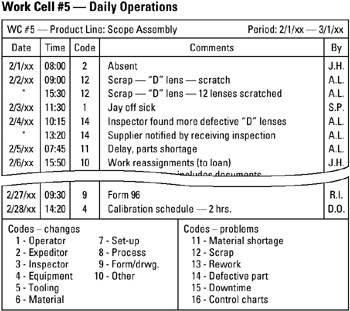Tools - E - I
Tool 71: Events Log
| AKA | Daily Operations Log |
| Classification | Changing/Implementing (CI) |
Tool description
An events log is a historical data trace for critical operations. It provides background information on process variation, changes in operations, supplier problems, and other information useful to problem-solving teams. Entries are made by anyone directly involved in the process and are checked frequently by the process owner.
Typical application
-
To detect any early trends that may result in a loss of quality or productivity.
-
To collect data for the purpose of monitoring operations.
-
To maintain a problem prevention procedure.
Problem-solving phase
| → | Select and define problem or opportunity |
| → | Identify and analyze causes or potential change |
| → | Develop and plan possible solutions or change |
| Implement and evaluate solution or change | |
| Measure and report solution or change results | |
| Recognize and reward team efforts |
Typically used by
| Research/statistics | |
| Creativity/innovation | |
| Engineering | |
| Project management | |
| 1 | Manufacturing |
| Marketing/sales | |
| 2 | Administration/documentation |
| Servicing/support | |
| Customer/quality metrics | |
| 3 | Change management |
before
-
Observation
-
Data collection strategy
-
Checklist
-
Process analysis
-
Problem analysis
after
-
Defect map
-
Countermeasures matrix
-
Quality chart
-
Monthly assessment schedule
-
Action plan
Notes and key points
-
Events are considered to be changes in people, equipment, tools, methods, forms, measurements, materials, suppliers, or environment. Frequently occurring problems must be included in the events log for possible future problem-solving activities.
Step-by-step procedure
-
STEP 1 An events log is started the first day of every month by the unit manager.
-
STEP 2 Entries are made for every event and each entry is coded for a specific meaning. See example Work Cell #5—Daily Operations.
-
STEP 3 The unit manager checks the events log on a daily basis for variations, patterns, trends, problem areas, etc.
-
STEP 4 Events logs are used in staff meetings and filed for future reference if needed.
Example of tool application

EAN: 2147483647
Pages: 326